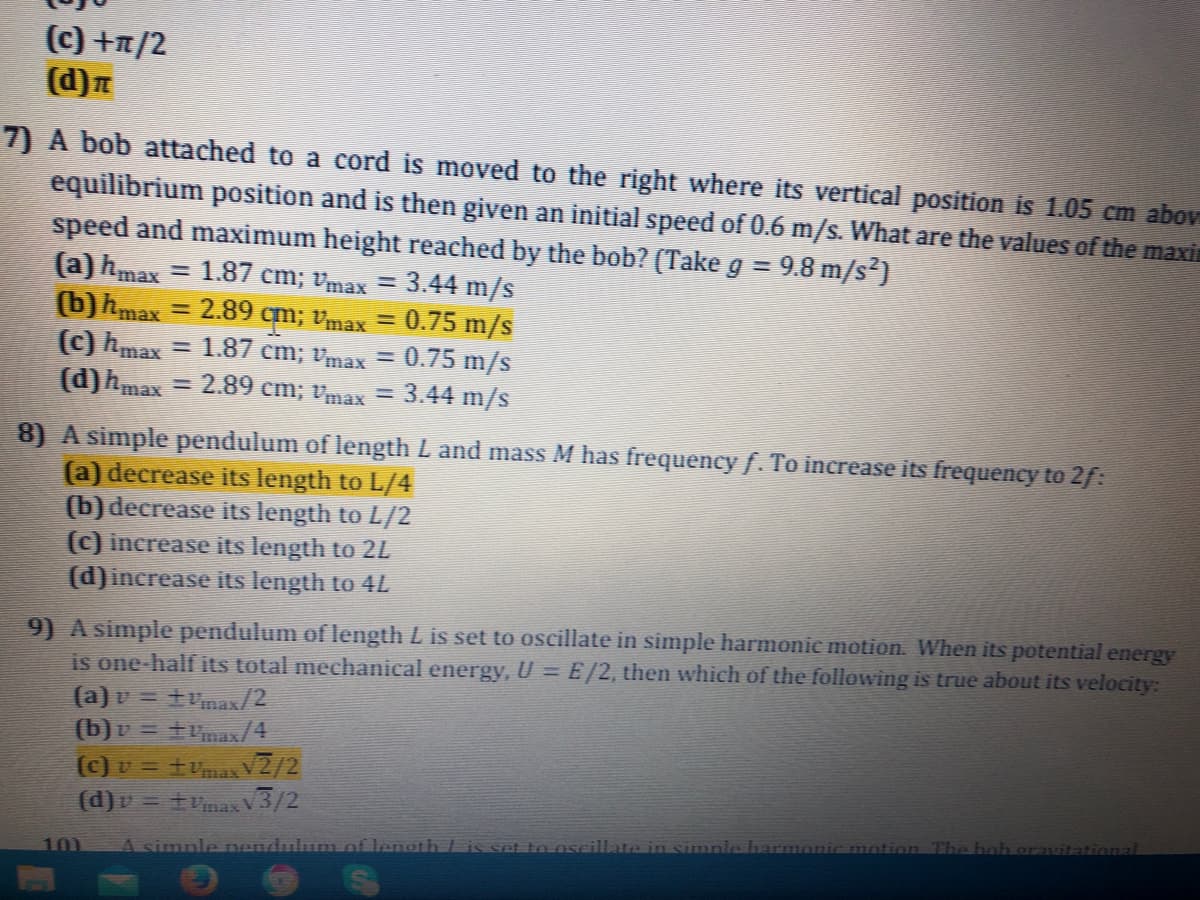7) A bob attached to a cord is moved to the right where its vertical position is 1.05 cm abo equilibrium position and is then given an initial speed of 0.6 m/s. What are the values of the max speed and maximum height reached by the bob? (Take g = 9.8 m/s²) (a) hmax (b) hmax = 2.89 cm; vmax = 0.75 m/s (c) hmax %3D 1.87 cm; vmax = 3.44 m/s %3D = 1.87 cm; Vmax = 0.75 m/s (d)hmax = 2.89 cm; vmax = 3.44 m/s
7) A bob attached to a cord is moved to the right where its vertical position is 1.05 cm abo equilibrium position and is then given an initial speed of 0.6 m/s. What are the values of the max speed and maximum height reached by the bob? (Take g = 9.8 m/s²) (a) hmax (b) hmax = 2.89 cm; vmax = 0.75 m/s (c) hmax %3D 1.87 cm; vmax = 3.44 m/s %3D = 1.87 cm; Vmax = 0.75 m/s (d)hmax = 2.89 cm; vmax = 3.44 m/s
College Physics
11th Edition
ISBN:9781305952300
Author:Raymond A. Serway, Chris Vuille
Publisher:Raymond A. Serway, Chris Vuille
Chapter1: Units, Trigonometry. And Vectors
Section: Chapter Questions
Problem 1CQ: Estimate the order of magnitude of the length, in meters, of each of the following; (a) a mouse, (b)...
Related questions
Question
100%

Transcribed Image Text:(c) +r/2
(d)n
7) A bob attached to a cord is moved to the right where its vertical position is 1.05 cm abov
equilibrium position and is then given an initial speed of 0.6 m/s. What are the values of the maxin
speed and maximum height reached by the beb? (Take g = 9.8 m/s?)
%3D
(a) hmax = 1.87 cm; vmax
(b)hmax
(c) hmax
(d)hmax =
3.44 m/s
0.75 m/s
= 1.87 cm; vmāx = 0.75 m/s
2.89 cm; vmax = 3.44 m/s
2.89
qm; Vmax =
%3D
8) A simple pendulum of length L and mass M has frequency f. To increase its frequency te 2f:
(a) decrease its length to L/4
(b) decrease its length to L/2
(c) increase its length to 2L
(d)increase its length to 4L
9) A simple pendulum of length L is set to oscillate in simple harmonic motion. When its potential energy
is one-half its total mechanical energy, U = E/2, then which of the following is true about its velocity:
(a) v = tvmax/2
(b)v = tax/4
(c) v = +vmax V2/2
(d)v = tvnax V3/2
at to ose
in simpl
otion The
101
A simple nandulum.of lenoth /
Expert Solution
This question has been solved!
Explore an expertly crafted, step-by-step solution for a thorough understanding of key concepts.
Step by step
Solved in 2 steps with 2 images

Knowledge Booster
Learn more about
Need a deep-dive on the concept behind this application? Look no further. Learn more about this topic, physics and related others by exploring similar questions and additional content below.Recommended textbooks for you

College Physics
Physics
ISBN:
9781305952300
Author:
Raymond A. Serway, Chris Vuille
Publisher:
Cengage Learning

University Physics (14th Edition)
Physics
ISBN:
9780133969290
Author:
Hugh D. Young, Roger A. Freedman
Publisher:
PEARSON

Introduction To Quantum Mechanics
Physics
ISBN:
9781107189638
Author:
Griffiths, David J., Schroeter, Darrell F.
Publisher:
Cambridge University Press

College Physics
Physics
ISBN:
9781305952300
Author:
Raymond A. Serway, Chris Vuille
Publisher:
Cengage Learning

University Physics (14th Edition)
Physics
ISBN:
9780133969290
Author:
Hugh D. Young, Roger A. Freedman
Publisher:
PEARSON

Introduction To Quantum Mechanics
Physics
ISBN:
9781107189638
Author:
Griffiths, David J., Schroeter, Darrell F.
Publisher:
Cambridge University Press

Physics for Scientists and Engineers
Physics
ISBN:
9781337553278
Author:
Raymond A. Serway, John W. Jewett
Publisher:
Cengage Learning

Lecture- Tutorials for Introductory Astronomy
Physics
ISBN:
9780321820464
Author:
Edward E. Prather, Tim P. Slater, Jeff P. Adams, Gina Brissenden
Publisher:
Addison-Wesley

College Physics: A Strategic Approach (4th Editio…
Physics
ISBN:
9780134609034
Author:
Randall D. Knight (Professor Emeritus), Brian Jones, Stuart Field
Publisher:
PEARSON